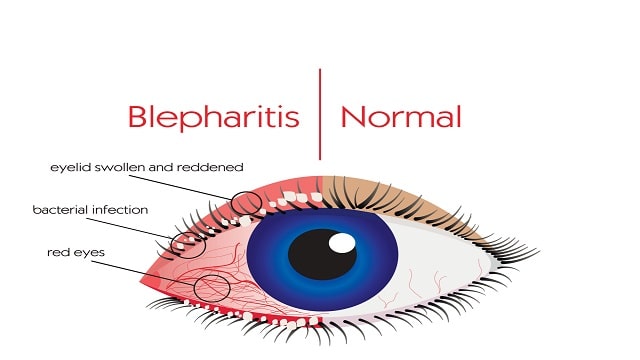Blepharitis
Blepharitis is an ophthalmological condition characterized by inflammation of the eyelid margin. This condition causes the area to become swollen and red. Typically, one eye appears more inflamed than the other. This eye condition can be acute or chronic.
This eye disease does not discriminate against age, meaning it can happen to anyone. There are at least three types of eye disease conditions, namely:
- Anterior blepharitis, this type is characterized by inflammation of the skin around the base of the eyelashes. This condition is due to the body’s reaction to Staphylococcus bacteria .
- Posterior blepharitis, this type causes inflammation of the meibomian glands due to blockage by dirt, inflammation, or skin debris.
- Mixed blepharitis, this type is a combination of anterior and posterior.
Symptoms of Blepharitis
Symptoms of this disease usually feel worse in the morning. It is important to note that blepharitis symptoms are not just about swelling or red eyelids. Here are some symptoms that are commonly experienced by blepharitis sufferers:
- The eyelids feel itchy.
- The eyes may appear watery or they may appear dry.
- Eyes feel gritty and hot.
- Peeling of the skin around the eyes.
- Eyelashes become crusty or greasy.
- The edges of the eyelids appear swollen.
- Eyelids become sticky.
- Eyes become sensitive to sunlight.
- Vision appears blurry.
- Abnormal eyelash growth.
- Without realizing it, the eyes blink more often.
- Discomfort when wearing contact lenses.
- Loss of eyelashes (in severe cases of blepharitis).
Causes of Blepharitis
The causes of blepharitis differ between acute and chronic. Acute blepharitis can be ulcerative or nonulcerative. Ulcerative blepharitis is caused by infection, usually by Staphylococcus bacteria . Viral infections such as Herpes simplex and varicella zoster infections can also cause ulcerative blepharitis. While nonulcerative blepharitis is usually an allergic reaction, such as atopic or seasonal.
In addition, the causes of this disease also vary depending on the location of the eye problem. Anterior blepharitis is usually caused by staphylococcal infection or seborrheic disease. Anterior blepharitis can also be associated with rosacea. While posterior blepharitis is caused by dysfunction of the Meibomian glands. These glands secrete excessive oily substances, causing the eyes to become blocked and enlarged. In mixed blepharitis (anterior and posterior blepharitis), the cause is Demodex mites.
Blepharitis Risk Factors
There are several risk factors that trigger this disease. For example:
- Bacterial infection.
- Dandruff on the scalp or eyebrows.
- Allergies due to the use of cosmetics.
- Side effects of drugs.
- The presence of lice on the eyelashes.
- There is an abnormality in the oil glands.
Diagnosis of Blepharitis
To diagnose this disease, the doctor will examine the patient’s eye condition. This examination focuses on the eyelids. In this examination, the doctor will use a tool such as a magnifying glass. The goal is to be able to see the patient’s eye condition in detail.
To establish a diagnosis, the doctor will usually take a sample of the crust or oil on the eyelid to be examined. Through this sample, it can be determined whether there is a fungal, bacterial, or allergic infection.
Complications of Blepharitis
Blepharitis can cause other eye problems, such as
- Abnormal eyelash growth.
- Eyelash loss.
- Stye. This can cause pain on the edge of the eyelid due to the developing infection.
- Injury to the eyelid.
- The shape of the edge of the eyelid changes (folding in or out).
- Chalazion. This is a sty-like bump that appears on the inside of the eyelid. Chalazion often occurs as a result of a stye that doesn’t heal. This eye problem can make your eyelid swollen and red, but chalazion usually heals on its own.
- Discomfort when wearing contact lenses.
- Corneal ulcers due to prolonged irritation.
- Corneal damage. In severe cases, blepharitis can scar your cornea (the clear outer layer at the front of your eye). This can happen because of swelling or irritation of your eyelids or eyelashes growing in the wrong direction.
- Dry eyes. Oil and debris can build up in your tear film (the thin layer of tears on the surface of your eyes). This can cause your eyes to feel dry or your eyes to water because your tears aren’t working properly.
Treatment Of Blepharitis
If the level of inflammation is not severe, blepharitis can be relieved by washing the eyes with clean water and compressing with warm water. However, if this method has not succeeded in reducing inflammation, then you should see a doctor for further medical treatment.
The treatment will be adjusted according to the results of the examination. For example, antibiotics in the form of eye drops and eye ointments will be prescribed by a doctor if the inflammation is caused by a bacterial infection. Especially in cases of infection that has spread beyond the eyelid, antibiotic eye drops are the most common drugs prescribed by doctors to treat the condition. If the condition does not improve with the use of medication in the eye, the doctor will prescribe oral antibiotics.
The doctor will prescribe steroid medication in the form of drops and ointments if the inflammation of the eyelids is not caused by infection. However, if the sufferer experiences irritation that causes dry eyes, the doctor will prescribe other medications. For example, eye drops that have a lubricating effect.
During treatment, it is advisable to consume foods containing omega-3. Examples of foods containing omega-3 include:
- Sardines, tuna, and salmon.
- Nuts.
- Soybeans and soybean products.
- Grains.
- Green leafy vegetables.
Prevention Of Blepharitis
To avoid blepharitis, wash your face thoroughly regularly every day. Also, keep your hands clean to avoid bacterial contamination when touching your eyes. If you usually wear makeup, don’t forget to clean it every night before going to bed.

